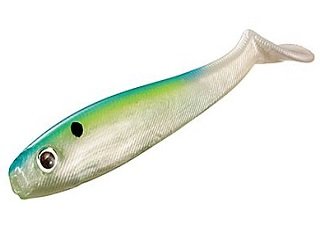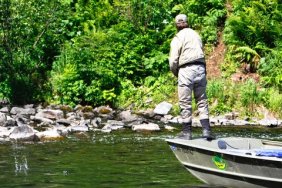 Swimbaits are such a popular bait for bass. Like crankbaits, they’re worked with a steady retrieve that allows for some erratic, attention-getting action, but they’re also soft plastic, which means they’re inexpensive and typically come in a variety of shapes, sizes and colors. Today, we’ll take a closer look at the basic design of swimbaits and explore what makes them so effective on the water.
Swimbaits are such a popular bait for bass. Like crankbaits, they’re worked with a steady retrieve that allows for some erratic, attention-getting action, but they’re also soft plastic, which means they’re inexpensive and typically come in a variety of shapes, sizes and colors. Today, we’ll take a closer look at the basic design of swimbaits and explore what makes them so effective on the water.
In essence, plastic swimbaits are designed to imitate baitfish such as shad, bluegill, or perch. They tend to possess long, slender bodies and a paddle tail that rapidly moves side to side during the retrieve to create water displacement and give the bait a more lifelike action. Most models also feature eyes to add more realism. Swimbaits are typically rigged Texas-style—weedless with a wide gap hook. There are hooks designed for swimbaits, as well, which have weighted shanks that allow them to be cast a mile and sink quicker (plastics don’t sink fast without weight).
You will, however, find a few variations between models made by different companies. For instance, some swimbaits, like some models made by Storm, come pre-rigged with hooks and internal weights, but aren’t weedless. Though they do snag now and then, I’ve used several of these with great success. You’ll also find differences in the body styles, such as hollow bodies (Luck-E-Strike), segmented bodies (Lake Fork), flat-nosed models (Yamamoto), ribbed bodies (Bass Pro Speed Shad), or even bodies molded to perfectly imitate a fish, complete with fins and texture (Berkley Havoc).
Most companies offer several different sizes for each color pattern their swimbaits come in, as well. I’ve used swimbaits ranging from one inch to six inches, and have caught fish on all of them, so you can have success no matter the size.
Like other soft plastics, you can find packages of a handful of swimbaits for as low as $4, or for as high as $10. It’s really going depend on what you’re looking for and how much you want to spend, though, Because they’re plastic, swimbaits can be ripped apart by toothy fish like walleye or pike, which don’t discriminate when they’re in the mood to strike. This can play a role in how much you’re willing to spend.
Swimbaits are a great bait for scanning the water to locate fish, as well as burning along the shoreline early in the morning. Furthermore, because they tend to be weedless, they can be used where other baits can’t. Pick up a pack or two if you’ve never tried them out, and see what kind of results they can yield this summer.








